Dentures & Partials

Dentures
A new set of dentures will feel very different than natural teeth, however, with our kind and caring staff here at Victorian Dental, we will help you through the transition process. Our denture lab utilizes high quality materials, while still allowing us to offer very competitive pricing.
There are several steps involved in the fabrication of a denture, and one must learn to chew and smile with new dentures, much like learning to ride a bike. Once a patient learns to wear properly fitted dentures, they quickly become more natural to be worn to the patient, much like wearing shoes. Often times, adjustments must be made to a new denture. These adjustments must be made in small increments to ensure the proper fitting of the final denture.
Another option is the relining of old dentures, depending on the age of the denture. The ability to reline dentures is on an individual basis, and depends greatly on the age of the denture.
Even though dentures are not real teeth, you should care for them like they are. You should brush them to remove plaque and food particles before removing your dentures. After they have been removed you should place them directly into room temperature water or a denture cleaning solution. Never use hot water because it could warp the dentures. Your dentures are delicate, so make sure you are careful when handling them so you don’t drop them. Also, never try to adjust your dentures yourself. You could ruin them, so you should always seek assistance from your dentist if they feel uncomfortable or loose.
Video of entire denture process:
Complete Denture Overview
Shows the process of delivering a complete denture from taking the impression to fitting it in the patient’s mouth. Orig. air date: SEP 9 93. This is part of the Open.Michigan collection at: http…
Overview
If you’ve lost all of your natural teeth, whether from periodontal disease, tooth decay or injury, complete dentures can replace your missing teeth and your smile. Replacing missing teeth will benefit your appearance and your health.
Without support from the denture, facial muscles sag, making a person look older. You’ll be able to eat and speak—things that people often take for granted until their natural teeth are lost.
There are various types of complete dentures. A conventional full denture is made and placed in the patient’s mouth after the remaining teeth are removed and tissues have healed which may take several months.
An immediate complete denture is inserted as soon as the remaining teeth are removed.
The dentist takes measurements and makes models of the patient’s jaws during a preliminary visit. With immediate dentures, the denture wearer does not have to be without teeth during the healing period.
Even if you wear full dentures, you still must take good care of your mouth. Brush your gums, tongue and palate every morning with a soft-bristled brush before you insert your dentures to stimulate circulation in your tissues and help remove plaque.
Frequently Asked Questions (FAQ)
. . .
Complete dentures are called “conventional” or “immediate” according to when they are made and when they are inserted into the mouth.
Immediate dentures are inserted immediately after the removal of the remaining teeth. To make this possible, the dentist takes measurements and makes the models of the patient’s jaws during a preliminary visit.
An advantage of immediate dentures is that the wearer does not have to be without teeth during the healing period. However, bones and gums can shrink over time, especially during the period of healing in the first six months after the removal of teeth. When gums shrink, immediate dentures may require rebasing or relining to fit properly.
A conventional denture can then be made once the tissues have healed. Healing may take at least 6-8 weeks.
New dentures may feel awkward for a few weeks until you become accustomed to them. The dentures may feel loose while the muscles of your cheek and tongue learn to keep them in place.
It is not unusual to experience minor irritation or soreness. You may find that saliva flow temporarily increases. As your mouth becomes accustomed to the dentures, these problems should diminish.
One or more follow-up appointments with the dentist are generally needed after a denture is inserted. If any problem persists, particularly irritation or soreness, be sure to consult your dentist.
Eating will take a little practice. Start with soft foods cut into small pieces. Chew slowly using both sides of your mouth at the same time to prevent the dentures from tipping. As you become accustomed to chewing, add other foods until you return to your normal diet.
Continue to chew food using both sides of the mouth at the same time. Be cautious with hot or hard foods and sharp-edged bones or shells.
Pronouncing certain words may require practice. Reading out loud and repeating troublesome words will help. If your dentures “click” while you’re talking, speak more slowly.
You may find that your dentures occasionally slip when you laugh, cough or smile. Reposition the dentures by gently biting down and swallowing. If a speaking problem persists, consult your dentist.
Your dentist will provide instructions about how long dentures should be kept in place. During the first few days, you may be advised to wear them most of the time, including while you sleep.
After the initial adjustment period, you may be instructed to remove the dentures before going to bed. This allows gum tissues to rest and promotes oral health. Generally, it is not desirable to wear dentures continuously.
Denture adhesive can provide additional retention for well-fitting dentures. Denture adhesives are not the solution for old, ill-fitting dentures. A poorly fitting denture, which causes constant irritation over a long period, may contribute to the development of sores.
These dentures may need a reline or need to be replaced. If your dentures begin to feel loose, or cause pronounced discomfort, consult with your dentist immediately.
Dentures are very delicate and may break if dropped even a few inches. Stand over a folded towel or a basin of water when handling dentures. When you are not wearing them, store your dentures away from children and pets.
Like natural teeth, dentures must be brushed daily to remove food deposits and plaque. Brushing helps prevent dentures from becoming permanently stained and helps your mouth stay healthy. It’s best to use a brush designed for cleaning dentures. A toothbrush with soft bristles can also be used. Avoid using hard-bristled brushes that can damage dentures.
Some denture wearers use hand soap or mild dishwashing liquid, which are both acceptable for cleaning dentures. Avoid using other powdered household cleansers, which may be too abrasive. Also, avoid using bleach, as this may whiten the pink portion of the denture.
Your dentist can recommend a denture cleanser. Look for denture cleansers with the ADA Seal of Acceptance. Products with the ADA Seal have been evaluated for safety and effectiveness.
The first step in cleaning dentures is to rinse away loose food particles thoroughly. Moisten the brush and apply denture cleanser. Brush every surface, scrubbing gently to avoid damage.
Dentures may lose their shape if they are allowed to dry out. When they are not worn, dentures should be placed in a denture cleanser soaking solution or in water. Your dentist can recommend the best method. Never place dentures in hot water, which could cause them to warp.
Ultrasonic cleaners are also used to care for dentures. However, using an ultrasonic cleaner does not replace a thorough daily brushing.
You can seriously damage your dentures and harm your health by trying to adjust or repair your dentures. A denture that is not made to fit properly can cause irritation and sores.
See your dentist if your dentures break, crack, chip, or if one of the teeth becomes loose. A dentist can often make the necessary adjustments or repairs on the same day. A person who lacks the proper training will not be able to reconstruct the denture.
This can cause greater damage to the denture and may cause problems in your mouth. Glue sold over-the-counter often contains harmful chemicals and should not be used on dentures.
Over time, dentures will need to be relined, rebased, or remade due to normal wear. To reline or rebase a denture, the dentist uses the existing denture teeth and refits the denture base or makes a new denture base. Dentures may need to be replaced if they become loose and the teeth show signs of significant wear.
Dentures become loose because a mouth naturally changes with age. Bone and gum ridges can recede or shrink, causing jaws to align differently. Shrinking ridges can cause dentures to fit less securely. Loose dentures can cause health problems, including sores and infections. A loose denture also makes chewing more difficult and may change your facial features. It’s important to replace worn or poorly-fitting dentures before they cause problems.
Your dentist will advise you about how often to visit. Regular dental check-ups are important. The dentist will examine your mouth to see if your dentures continue to fit properly. The dentist also examines your mouth for signs of oral diseases including cancer.
With regular professional care, a positive attitude and persistence, you can become one of the millions of people who wear their dentures with a smile.
Partials
Overview
Removable partial dentures usually consist of replacement teeth attached to pink or gum-colored plastic bases, which are connected by metal framework.
If you are missing only a few teeth scattered over either arch (upper or lower teeth), or even if you have a minimum of two teeth on both sides of the arch, then you can most inexpensively replace the missing teeth with a removable partial denture (RPD).
There are several types of RPD’s. All of them use standard plastic denture teeth as replacements for the missing natural teeth. The differences between them are the materials that are used to support the denture teeth and retain the RPD in the mouth.
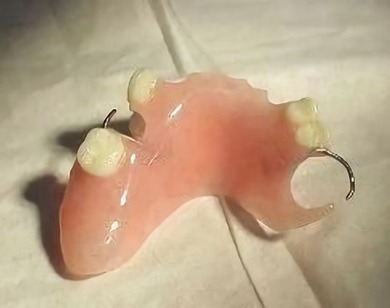
RPD (flippers)
Affectionately known in dentistry as a “flipper”, this is the least expensive of all the removable partial dentures. The one pictured on the left replaces 4 missing upper teeth, leaving spaces for 7 natural teeth.
Two of the natural teeth are clasped with wrought wire clasps which are cured into the structure of the denture base. When a flipper is intended for temporary use while replacing one or more front teeth, it is often termed a “stayplate”.
Most frequently, these are intended to be used only for several months while awaiting healing during the various phases of implant placement.
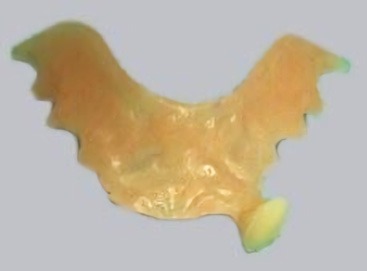
The plastic of the denture base is brittle acrylic, the same material used to make standard full dentures. The greatest advantage to this type of RPD (aside from the cost) is that new teeth, and denture bases can easily be added to an existing treatment RPD.
These are frequently fabricated even if the remaining teeth have existing decay, or Periodontal disease, and their prognosis is doubtful. If later in the course of treatment some of the existing natural teeth are extracted for any reason, new false teeth can be added quickly to the partial, maintaining the patient’s appearance.
In spite of the fact that they are considered a temporary solution, many people keep this type of appliance for many, many years. As long as they are properly maintained, they look as good as the more expensive permanent appliances described below.
Flipper Disadvantages
- The acrylic denture base is somewhat brittle, and due to their irregular shape, these partials tend to break frequently, especially those made for the lower arch. (Full dentures are more regular in shape and tend to be fairly strong as a result.)
- In order to counteract their tendency to break, the acrylic is usually built fairly thick which can take some "getting used to".
- The denture base rests only on the gums, and even though they are much more stable than full dentures, they are much less stable than the more permanent RPD's which are "tooth born".
- As the gums resorb, The false teeth tend to sink below their original level making it necessary to reline them frequently, and sometimes even to reset the teeth which adds to their expense.
- Flippers are most frequently retained with wire clasps (shown in image above). These are frequently unsightly due to the limitations that pertain to their placement (they can't interfere with the way you bite).
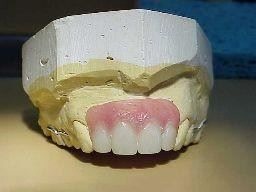
Cast Metal RPD's
Removable Partial Dentures with cast metal frameworks are probably one of the oldest forms of dentistry. Originally, the frameworks (an example seen on the right) were made out of wrought (hammered) silver.
One of the most famous American dentists was Paul Revere who was a silversmith when he wasn’t fighting redcoats.
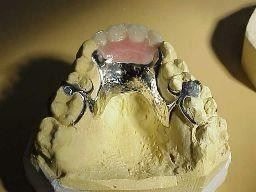
The metal framework does not contact the gums. Thus, as the gums resorb, this type of partial does not sink with them and rarely requires relines. Because the teeth are altered by the dentist beforehand, there are fewer limitations in the placement of clasps, and they are less likely to be seen than the wrought wire clasps of the treatment partial.
Modern frameworks are cast from an extremely strong alloy called chrome cobalt which can be cast very thin and are much less likely to break than the all plastic variety. They are also much less noticeable to the tongue.
The best advantage that cast metal framework partial dentures have over the newer flexible framework partials (covered below) is that sore spots are almost never an issue since neither the framework, nor the plastic extensions, contact the soft oral tissues with any force. Patients who exhibit the symptoms of TMJ, or who are known teeth grinders are much better off with cast metal partials than with flexible framework partials.ng the options from the toolbar.
The flexible framework RPD
. . .
The most recent advance in dental materials has been the application of nylon-like materials to the fabrication of dental appliances. Nylon generally replaces the metal, and the pink acrylic denture material used to build the framework for standard removable partial dentures. Nylon is similar to the material used to build those fluorescent orange traffic cones you sometimes see on highways.
It is nearly unbreakable, is colored pink like the gums, can be built quite thin, and can form not only the denture base, but the clasps as well. Since the clasps are built to curl around the necks of the teeth, they are practically indistinguishable from the gums that normally surround the teeth. Brands of this type are: Luciton FRS, Sunflex, TCS, Duraflex, Valplast, and Flexstar.
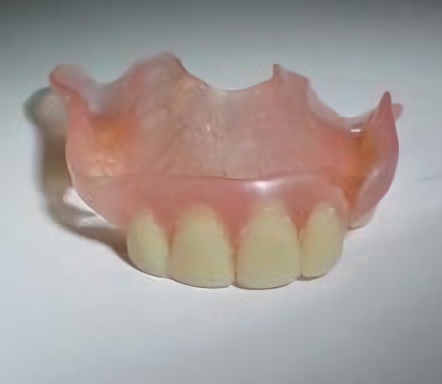
A second type of flexible partial denture base uses a vinyl composite instead of nylon. The most commonly sold brand is Flexite. A second brand Is Ultraflex. These materials are also flexible and can be built with tooth or gum colored clasps. Ultraflex even comes in a clear variety. Unlike nylon partial dentures, they are much easier for the dentist to adjust making them a much more “user friendly” denture base.
Even though this type of denture does not rest on the natural teeth like the metal framework variety, the clasps rest on the gums surrounding the natural teeth. This tissue, unlike the gums over extraction sites, is stable and changes very little over time which keeps these RPD’s stable and unchanging similar to the cast metal variety. The clasps can be seen (if you look hard) on the image on the right below just under my thumb and index fingers. This type of partial denture is extremely stable and retentive, and the elasticity of the flexible plastic clasps keeps them that way indefinitely.


The Vitallium/Nylon Partial denture
A good alternative to the all-nylon partial denture is one made with a combination cast metal framework with nylon clasps.
This has the advantage of being tooth supported (like the cast metal framework partial denture discussed above) and also having gum colored plastic clasps like the nylon partial.
This combination of metal framework and plastic clasp eliminates most of the difficulty of recurrent sore spots, since the framework resists movement and pressure from the clasps, while having the benefit of nearly invisible clasps.

The Nesbit RPD
Dentists used to build Nesbits for their patients all the time. They were composed of a single denture tooth (usually a back tooth) between two cast metal clasps which attached onto the teeth on either side of the missing one. They looked a little like spiders when out of the mouth. Patients tended to like them, but they came to an abrupt end in the 1970’s.
Prior to that time, in the rare event that a patient swallowed his appliance, he either waited for it to pass, or sought medical help on his own assuming that the accident was his own fault. In rare instances, the metal clasps were sharp enough to cause damage to the digestive system. After that time, many lawyers discovered that it was a fitting law suit, and due to this it didn’t take the dental profession long to abandon this service.
The design of the new flexible plastic framework takes the danger out of an accidental swallowing of the appliance. In the event that someone did swallow one, it is unlikely that any damage would be done to the lining of the digestive system.
Frequently Asked Questions (FAQ)
. . .
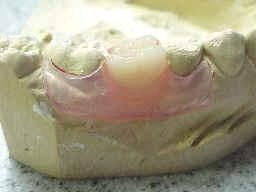
Removable partial dentures usually consist of replacement teeth attached to pink or gum-colored plastic bases, which are connected by metal framework. Removable partial dentures attach to your natural teeth with metal clasps or devices called precision attachments. Precision attachments are generally more aesthetic than metal clasps and they are nearly invisible.
Crowns on your natural teeth may improve the fit of a removable partial denture and they are usually required with attachments. Dentures with precision attachments generally cost more than those with metal clasps. Consult with your dentist to find out which type is right for you.
Your dentist will give you specific instruction about how long the denture should be worn and when it should be removed. Initially, you may be asked to wear your partial denture all the time. Although this may be temporarily uncomfortable, it is the quickest way to identify those denture parts that may need adjustment.
If the denture puts too much pressure on a particular area, that spot will become sore. Your dentist will adjust the denture to fit more comfortably. After making adjustments, your dentist will probably recommend that you take the denture out of your mouth before going to bed and replace it in the morning.
Handling a denture requires care. It’s a good idea to stand over a folded towel or a sink of water just in case you accidentally drop the denture. Brush the denture each day to remove food deposits and plaque. Brushing your denture helps prevent the appliance from becoming permanently stained. It’s best to use a brush that is designed for cleaning dentures. A denture brush has bristles that are arranged to fit the shape of the denture. A regular, soft-bristled toothbrush is also acceptable. Avoid using a brush with hard bristles, which can damage the denture.
Dr. Rae can recommend a denture cleaner. Look for denture cleansers with the American Dental Association (ADA) Seal of Acceptance. Products with the ADA Seal have been evaluated for safety and effectiveness.
Some people use hand soap or mild dishwashing liquid to clean their dentures, which are both acceptable. Other types of household cleaners and many toothpastes are too abrasive and should not be used for cleaning dentures.
Clean your dentures by thoroughly rinsing off loose food particles. Moisten the brush and apply the denture cleaner. Brush all denture surfaces gently to avoid damaging the plastic or bending the attachments.
A denture could lose its proper shape if it is not kept moist. At night, the denture should be placed in soaking solution or water. However, if the appliance has metal attachments, they could be tarnished if placed in soaking solution. Your dentist can recommend the proper method for keeping your dentures in good shape.
